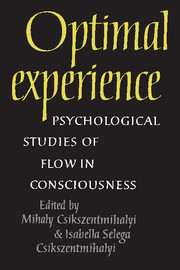Book contents
- Frontmatter
- Contents
- Acknowledgments
- Contributors
- I A THEORETICAL MODEL OF OPTIMAL EXPERIENCE
- II VARIETIES OF THE FLOW EXPERIENCE
- 5 Introduction to Part II
- 6 Bosozoku: flow in Japanese motorcycle gangs
- 7 Women, work, and flow
- 8 The relationship between life satisfaction and flow in elderly Korean immigrants
- 9 Flow and writing
- 10 Flow in solitary ordeals
- III FLOW AS A WAY OF LIFE
- IV THE MEASUREMENT OF FLOW IN EVERYDAY LIFE
- References
- Name index
- Subject index
8 - The relationship between life satisfaction and flow in elderly Korean immigrants
Published online by Cambridge University Press: 05 June 2012
- Frontmatter
- Contents
- Acknowledgments
- Contributors
- I A THEORETICAL MODEL OF OPTIMAL EXPERIENCE
- II VARIETIES OF THE FLOW EXPERIENCE
- 5 Introduction to Part II
- 6 Bosozoku: flow in Japanese motorcycle gangs
- 7 Women, work, and flow
- 8 The relationship between life satisfaction and flow in elderly Korean immigrants
- 9 Flow and writing
- 10 Flow in solitary ordeals
- III FLOW AS A WAY OF LIFE
- IV THE MEASUREMENT OF FLOW IN EVERYDAY LIFE
- References
- Name index
- Subject index
Summary
What makes for successful aging has been one of the main concerns of psychological and social gerontology since Havighurst's pioneering work over 30 years ago (Havighurst & Albrecht 1953). Since then, many studies have tried to assess qualitative differences in patterns of aging and to find variables related to successful aging (Larson 1978).
Such concepts as life satisfaction, morale, and adjustment have been widely used to measure success in the later years of life. Even though these concepts are different from each other in content and major focus, it is assumed that they refer to the same underlying construct. Lohman (1977), for instance, found that there is a high level of correlation among widely used measures of life satisfaction, morale, and adjustment.
As Neugarten, Havighurst, and Tobin (1961) suggested, life satisfaction is not a unidimensional concept. In their original formulation of the Life Satisfaction Index, five distinct components of life satisfaction were identified: zest vs. apathy; resolution and fortitude; congruence between desired and achieved goals; positive self-concepts; and positive mood tone. This multidimensionality has been confirmed by Adams (1969), who factor-analyzed responses to the Life Satisfaction Index A (LSIA). Knapp (1976) obtained the same results, concluding that the Life Satisfaction Index should be treated as a multidimensional measure. Using this multidimensional framework, Hoyt, Karser, Perters, and Babchuck (1980) found that some dimensions show a better fit than others between life satisfaction and social activity.
- Type
- Chapter
- Information
- Optimal ExperiencePsychological Studies of Flow in Consciousness, pp. 138 - 149Publisher: Cambridge University PressPrint publication year: 1988
- 42
- Cited by



